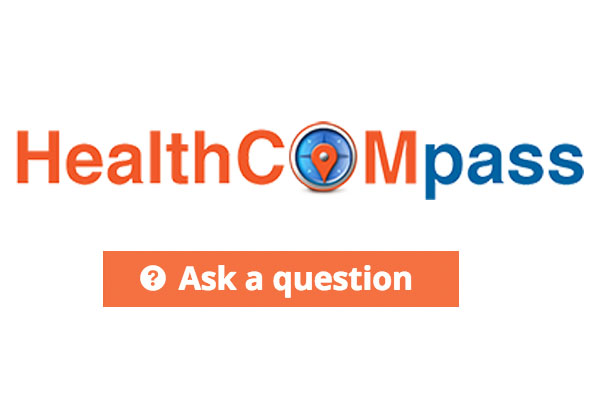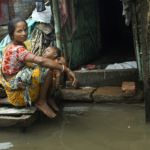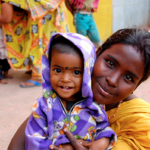Got Questions? The Health COMpass offers the “Human Touch”
In this world of instant information, data beyond counting and websites that know what you are looking for before you type in a single word, it seems we still find ourselves (or perhaps even more often find ourselves) needing help….from a real honest to goodness live human being. We search, we go from link to link, yet there are times when we wish there was someone who could help guide us through all of the possibilities.
Information specialists feel the same way – in fact, many find it incredibly rewarding to connect with users and be able to answer a question. It is fun and interesting for both user and information professional to have the healthy back and forth that comes with trying to find the best resource or piece of information possible.
 The Health COMpass has always offered the “Ask a Question” button – placed at the bottom right of each page of the site. It has proven quite helpful to our users who can get “stuck” with the hundreds, thousands, even millions of resources to which they have access.
The Health COMpass has always offered the “Ask a Question” button – placed at the bottom right of each page of the site. It has proven quite helpful to our users who can get “stuck” with the hundreds, thousands, even millions of resources to which they have access.
I’m pleased to share with you some of our best “Ask a Question” stories – and hope that users of the Health COMpass continue to avail themselves of this unique service.
Below are examples of some of our recent questions, and responses, and hope that all of you who use the Health COMpass will feel comfortable asking for help when you need it.
Q: I’d like to adapt the information in this flipchart, from Ghana, for our work in Zambia – can you help me find hard copies of the flipchart? – Peace Corps Rep, Zambia:
A: PDFs of the flipchart were offered.
Q: Do you have a template we could use in implementing the P Process? – US Army Health Communication Officer
A: Several templates and examples of the P Process in use were sent:
- Making Health Communication Programs Work (US CDC)
- Field Guide to Designing a Health Communication Strategy
- Search Results: SBCC Tools
Q: Where can I find Brothers for Life around Soweto that operates during the weekend. Need to [find out more about] HIV with my partner. – Individual in Soweto
A: This person was referred to a phone number and clinic locator on the Brothers for Life website.
Q: When coming up with a communication strategy what are the key principles? – Officer in MOH Kenya National Malaria Control Program
A: Links to three strategy documents on the Health COMpass were sent:
- Making Health Communication Programs Work (US CDC)
- Field Guide to Designing a Health Communication Strategy
- CDC Synergy
Q: How do you use audience segmentation to ensure food safety? – [Identity, Organization, Location unknown]
A: An expert at Johns Hopkins Center for Communication Programs was asked and this response was sent:
“Audience segmentation alone will not ensure food safety. It is one task in a larger process and will help you to identify the audience you should focus on during a health communication intervention which can work to change behaviors by addressing the barriers and facilitators, community norms, etc. Often, when a communication intervention is designed it attempts to address every audience when in fact you should be designing messages and materials to reach a specific audience.
After doing a situation and audience analysis you will be better able to identify the right audience you want to focus on. Audience segmentation will take the broad audience and help you to further identify characteristics that can further narrow down and provide focus. That way messages and materials can be designed specifically for that audience. For example, you may find during your analysis that one of the barriers in food security is planning and storage. Not all the men are responsible for this, rather the elders are responsible for the planning and the young unmarried men are responsible for storage. The messages would be different and it may be important to segment the audience to this level to be able to design relevant messages that would have the impact. Obviously food security is much more complex and this is just an example.”
Q: Do you know of a database or resources to help me with this project? – Medical Student, Tanzania, working on a project on mobile health service provision for mother and child
A: A list of resources on the Health COMpass was sent:
- Key Messages for 1000 Special Days (Malawi)
- Five Key Messages Essential for Newborn Care
- Text4baby Mobile App
- Nutrition during Pregnancy and Breastfeeding
- Taking Care of Baby at Home after Birth
- SBCC I-Kit Support for Faith-Based Organizations Breastfeeding Interventions
- MomConnect
- Give Your Baby a Healthy Start
Q: Kindly inform how can we calculate the number or percentage of married women & pregnant women in a population at any given point in time. – Staff member at Marie Stopes, Kenya
A: Two links to calculation tables were recommended:
- Info on married women – http://www.un.org/en/development/desa/population/theme/marriage-unions/marriage_estimates.shtml
- Calculator for how many women are pregnant at any given time – iawg.net/resources/MISPcalculator.xls
Many of us rely heavily on the online resources available, which are impressive, broad-ranging and incredibly reliable. But somewhere along the line we may have forgotten that there are humans behind all of that information and those humans are happy to talk to us and help us.
So whatever you are researching, don’t forget the human component – reach out to the organization, and don’t be afraid to Ask a Question.








Leave a Reply
Want to join the discussion?Feel free to contribute!